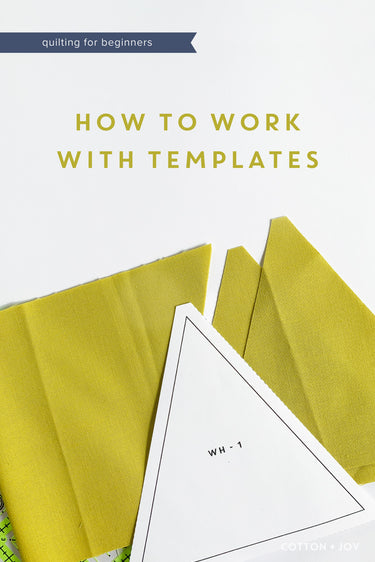When I first outlined my Quilting for Beginners series, I did not include a post on working with templates. However, after releasing the Tree Farm pattern, the question came up on Instagram, and I realized it’d be an excellent topic to cover on here.

While most beginner quilt patterns do not include templates, curved piecing is in right now in modern quilting and so are irregular shapes and those two things will require working with templates. And here's the thing - it's way easier and way less scary than it sounds!
That's a true story! Templates are not hard, but they can trip you up in unexpected ways. So below are some key tips on working with templates so you can get to quilting!
Printing Your Templates
If you've purchased your pattern online as a PDF download, you will need to print the templates yourself. This first step is usually where things go awry. There is ONE THING to keep in mind when printing these out.
Most printers default to "Scale to Fit", which is fine for most printing needs (because no one likes a cut-off copy of something or other) but this is no good for templates because it'll make them just slightly smaller. So, make sure your printer is set to "Scale: 100%" or "Actual Size".

You can double check that your template printed to the correct scale by measuring the "Test Square" or ruler included in most templates. The square or ruler will usually be an inch, and you can use a ruler to make it's truly an inch, and therefore it printed correctly before cutting your fabric.

Cutting Your Templates
After you've made sure your templates printed correctly, it's cutting time! When cutting templates with straight lines, I prefer to use my rotary cutter and ruler for speed and better accuracy.
I have a rotary cutter specifically for paper cutting since I've been doing some paper piecing as well, but you don't have to go that far. However, if you decide to go the scissor route, make sure you use your paper scissors. Nothing worse than dull scissors!

The most important thing when cutting your templates though is precision. As you are cutting, make sure you do so carefully and accurately. If your template is just slightly off, your fabric will be just slightly off and it can lead to some headaches during piecing.
If you're using the same template to cut a lot of pieces, I recommend printing the template on a thicker paper or transferring it to a vinyl sheet. You can trace your template onto the sheets and cut the shape out and it will help you stay accurate as you cut the same piece over and over.
Cutting Your Fabric
This is the truly scary part, but as long as you made sure to print the templates at the correct size and cut them carefully, there is nothing to fear! Just cut as closely to the template as possible.
However, here are some additional tips:
- Minimize the number of cuts you can to make by cutting strips of fabric the same width or height of your template. You can see what I mean on the pictures below.


- Pay attention to prints and direction! Unless pattern specifically tells you to flip a template, pay attention to the direction the print on your fabric is going, otherwise, you might end up with some sideways or upside down prints. (If this scares you or makes you nervous, opt for non-directional prints, a solid or batik fabric!)
- Whenever possible cut with the grain of the fabric - along the width and length) to avoid having bias edges (cuts going diagonally). Cutting fabric on the bias makes it prone to stretching. If there is no way to avoid cutting a bias edge, consider using starch to avoid inadvertly stretching your fabric while piecing.
The bottom line, templates aren't as scary as they seem! :)
Update - Curve Templates
Since I first wrote this blog post, I've released a couple of new patterns that use curve templates. So here's a quick video showing you how to cut those templates :)
Ready to work with templates? Get these patterns!
Patterns with Non-Curve Templates
Patterns With Curve Templates
In case you'd rather not mess with cutting out curved templates, I worked with Riley Blake Designs to create my very own acrylic templates! They make working with curved piecing so much easier. If you'd like to purchase my Modern Curves Templates, click here for more information!









